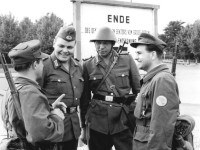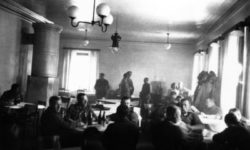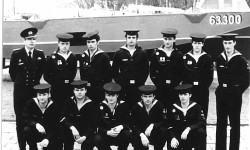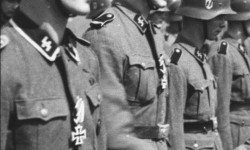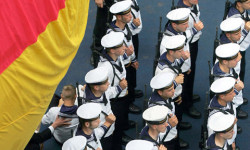The execution of the rank insignia followed in their appearance the tradition of the Wehrmacht, however with some modifications. Thus, the arm angles of the corporal and corporal were replaced by one or two crosspieces on the axillary flaps. The stocking of trimmings on the collars and underarm flaps of the NCOs and Sub-Sergeants, on the other hand, remained unchanged in comparison to the Wehrmacht, as did the star distinctions for Sergeant, Sergeant and Staff Sergeant. The shoulder pieces of the officers were a compromise solution: the basic form of flat cord or wicker work and the shape of the Rangsterne agreed with those of the Reichswehr. However, the order of rank stars followed the pattern of the Soviet Army - as in all other Warsaw Pact states as well.
With the introduction of the Soviet rank structure for the officers, the rank of the second lieutenant was also reintroduced (in Germany, the name Unterleutnant after 1898 had fallen into disuse). In return, the rank of General of the Military Division (General of the Infantry, General of Artillery, etc.) who up to now had been the next in command of the Lieutenant-General was dropped. This was followed immediately by the Colonel-General, followed by the Army General.
Also the Soviet pattern was followed by the introduction of the rank-ranked group of cadets in 1974, five years later extended by the ranks Oberfähnrich, Stabsfähnrich and Stabsoberfähnrich. These ranked among the sergeants and the officers. Her rank insignia consisted of two silverplate cords laid on the base cloth of the shoulder flaps. To introduce the rank order group of the midshipmen they wore two superimposed golden Rangsterne. As a special marking the cadets wore on the left upper arm of the uniform an insignia. Initially, this number was the number of seniority reflected on this star. After ten years of service, there was the first star, after 15 and 20 years each have another star. On October 1, 1979 more Fähnrichsgrade degrees were introduced and that after the ensign of the Ober-, Stabs- and Stabsoberfähnrich. To distinguish then served one to four vertically superimposed rank stars that were only for a very short time, about a week, silver. Due to massive complaints of the midshipmen, who felt a star less and the change of the star color from gold to silver as a downgrade, was returned to gold-colored stars. With the introduction of the other Fähnrichsdienstgrade the stars were omitted on the sleeve badge. The cadets wore the uniform and equipment of the officers, which, however, the worn to parade uniform silver bandage, the honor dagger and from 1977 the Achselschnur reserved.
crews
- Soldat (soldier)
- Gefreiter (private first classes)
- Stabsgefreiter (staff private first class)
- Unteroffiziersschüler (Noncommissioned officer's recruit)
Soldat (soldier)(1), Gefreiter (private first classes)(2), Stabsgefreiter (staff private first class)(3), Unteroffiziersschüler (Noncommissioned officer's recruit)(4)
noncommissioned officer ranks
- Unteroffizier (noncommissioned officer)
- Unterfeldwebel (under sergeant)
- Feldwebel (Sergeant)
- Oberfeldwebel (Technical sergeant)
- Stabsfeldwebel (Csms)
Unteroffizier (noncommissioned officer)(1), Unterfeldwebel (under sergeant)(2), Feldwebel (Sergeant)(3), Oberfeldwebel (Technical sergeant)(4), Stabsfeldwebel (Csms)(5)
Officer cadet's corps and officer cadet's schoolboy
- Fähnrichschüler (Officer cadet schoolboy)
- Fähnrich (Officer cadet)
- Oberfähnrich (Upper officer cadet)
- Stabsfähnrich (Stick officer cadet)
- Stabsoberfähnrich (Stick upper officer cadet)
Fähnrichschüler (Officer cadet schoolboy) (1), Fähnrich (Officer cadet) (2), Oberfähnrich (Upper officer cadet) (3), Stabsfähnrich (Stick officer cadet) (4), Stabsoberfähnrich (Stick upper officer cadet) (5)
officers
- Offiziersschüler (Officer's schoolboy)
- Unterleutnant (Under Second lieutenant)
- Leutnant (Second lieutenant)
- Oberleutnant (first lieutenant)
- Hauptmann (Captain)
- Major (major)
- Oberstleutnant (lieutenant colonel)
- Oberst (Colonel)
Offiziersschüler (Officer's schoolboy) (1), Unterleutnant (Under Second lieutenant) (2), Leutnant (Second lieutenant) (3), Oberleutnant (first lieutenant) (4), Hauptmann (Captain) (5), Major (major) (6), Oberstleutnant (lieutenant colonel) (7), Oberst (Colonel) (8)
Generals
- Generalmajor (major general)
- Generalleutnant (lieutenant general)
- Generaloberst (Colonel General)
- Armeegeneral (army General)
- Marschall der DDR (Marshal of the DDR)
Generalmajor (major general) (1), Generalleutnant (lieutenant general) (2), Generaloberst (Colonel General) (3), Armeegeneral (army General) (4), Marschall der DDR (Marshal of the DDR) (5)
This post is also available in:
 Deutsch (German)
Deutsch (German)  Français (French)
Français (French)  Italiano (Italian)
Italiano (Italian)  简体中文 (Chinese (Simplified))
简体中文 (Chinese (Simplified))  Русский (Russian)
Русский (Russian)  Español (Spanish)
Español (Spanish)  العربية (Arabic)
العربية (Arabic)

